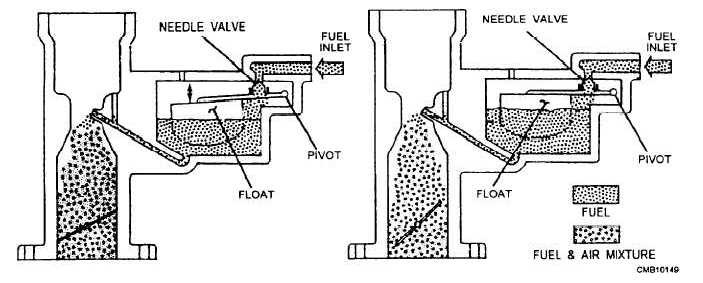Understanding each of these systems is important. It will help you when diagnosing and repairing carburetor problems.
Float System
The float system (fig. 4-20) maintains a steady working supply of gasoline at a constant level in the carburetor. This action is critical to the proper operation of the carburetor. Since the carburetor uses differences in pressure to force fuel into the air horn, the fuel bowl must be kept at atmospheric pressure. The float system keeps the fuel pump from forcing too much gasoline into the carburetor bowl. An excessively high float level will cause fuel to flow too freely from the discharge tube, causing an overly rich mixture, whereas an excessively low float level will cause an overly lean mixture. The basic parts of the float system are the fuel bowl, the float, the needle valve, the needle seat, the bowl vent, and the hinge assembly. Study the relationship of each part as follows:
The CARBURETOR FLOAT rides on top of the fuel in the fuel bowl to open and close the needle valve. It is normally made of thin brass or plastic. One end of the float is hinged to the side of the carburetor body and the other end is free to swing up and down.
The NEEDLE VALVE regulates the amount of fuel passing through the fuel inlet and the needle seat. The needle valve is usually made of brass. Sometimes the end of the valve will have a soft viton (synthetic rubber) tip. The soft tip seals better than a metal tip, especially if dirt gets caught in the needle seat.
The NEEDLE SEAT works with the needle valve to control fuel flow into the bowl. It is a brass fitting that threads into the carburetor body.
The BOWL VENT prevents pressure or vacuum buildup in the carburetor fuel bowl. Without venting, pressure could form in the bowl, as the fuel pump fills the carburetor. This could also cause vacuum to form in the bowl, as fuel is drawn out of the carburetor and into the engine. On vehicles equipped with an evaporation control type emission system, the fuel bowl is vented into a hose going to a charcoal canister instead of the outside. The canister stores toxic fuel vapors and prevents them from entering the atmosphere.
Basic float system operation is as follows:
When engine speed or load increases, fuel is rapidly pulled out of the fuel bowl and into the venturi. This action causes the fuel to drop in the bowl. The needle valve also drops away from its seat. The fuel pump can then force more fuel into the bowl.
As the fuel level in the bowl rises, the float pushes the needle valve against its seat. When the fuel level is high enough, the float closes the opening between the needle valve and the seat by the rising float, as the fuel reaches the desired level in the fuel bowl.
With the engine running, the needle valve usually lets some fuel leak into the bowl. As a result, the float system maintains a stable quantity of fuel in the bowl. This is very important because the fuel level in the bowl can affect the air-fuel ratio.

Figure 4-20. - Float system.
Continue Reading